The Transportation & Infrastructure goals in SomerVision2030 include both far-reaching thinking about how to protect the right of ways for potential future projects like the Urban Rail Radial Project, as well as tactical everyday life issues like vehicular congestion. In addition, this section considers what kinds of water, sewer, energy, and utility improvements are needed to support future growth and an attractive, functional city.
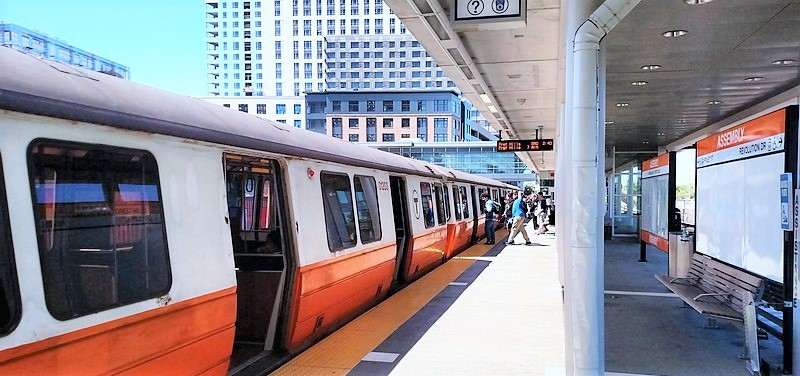
I. Create a mass transit network accessible to all parts of the city and all users, with innovative physical and informational improvements that allow for easy use and seamless intermodal connections.
II. Increase active and alternative transportation options; reduce congestion and promote workplace-based policies and incentives for mode choice, work hours, and employment location.
III. Expand bike and pedestrian culture by transforming existing infrastructure to accommodate bicyclists and pedestrians, resulting in safe, accessible and well-connected networks.
IV. Use technology and infrastructure improvements to balance the needs of pedestrians, bicyclists,
private vehicles, and mass transit; reduce congestion and pollution; decrease road space dedicated to private automobiles, and unlock economic development potential while maintaining a fiscally sound road maintenance program.
V. Manage parking supply and demand in a flexible, rational and innovative manner
VI. Connect the city: retrofit, redesign, and build, as necessary, roads, bridges, paths, and rights-of-way to improve transportation networks and link neighborhoods and commercial centers within Somerville and beyond.
VII. Provide a safe, high quality, potable water system that is well maintained, financially solvent and accommodates the future growth needs of the city.
VIII. Improve stormwater and wastewater management systems to increasingly separate stormwater and sewerage and support desired levels of future growth.
IX. Maximize environmental sustainability in the design and implementation of all infrastructure systems
X. Move toward energy self-sufficiency by increasing supply of locally generated power and reducing per capita energy demand.
XI. Ensure utility infrastructure is sufficient in capacity and quality, uses the best available technologies, has redundancy, and supports the desired level of future growth.
- Rail improvements: The Green Line Extension is in construction, Assembly Square T Station has been operational since 2014, and neighborhood plans continue to push the envelope in transportation planning including expanding the Union Square spur of the Green Line to Porter Square on existing railway and creating the yellow line on the Grand Junction right-of-way.
- Bus improvements: Transportation planners are working with the MBTA to improve bus travel times throughout all neighborhoods of Somerville. Many times, this is bringing bus routes up to industry best practices including merging stops that are too close together, moving to far-sided bus stops, and improving routes.
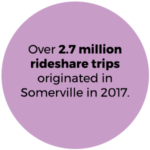 Mobility Management: The Assembly Square Transportation Management Association (TMA) is coming online. Mobility management requirements, including in Union Square and Boynton Yards, will likely result in more TMA’s. The purpose of these requirements is to best manage transportation in the district and facilitate connections not provided by transit to lower drive-alone commuters, vehicle emissions, and increase transit options.
Mobility Management: The Assembly Square Transportation Management Association (TMA) is coming online. Mobility management requirements, including in Union Square and Boynton Yards, will likely result in more TMA’s. The purpose of these requirements is to best manage transportation in the district and facilitate connections not provided by transit to lower drive-alone commuters, vehicle emissions, and increase transit options.- Blue Bikes: Somerville joined the Blue Bikes program (then called Hubway) right after SomerVision 2030 was adopted. This year, Somerville expanded to 21 docking stations and saw ridership go up 50% compared to the same time last year.
- Cyclist Infrastructure: Encouraging all types of cyclists means designing a place to ride that is safe from automobiles. Somerville has created on average 1.5 miles of new bikes lanes per year over the last 10 years.
GET INVOLVED: Learn more about the Somerville Bicycle Committee.
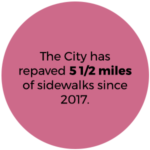 Traffic Signal Timing and Technology Improvements: Transportation planners are studying signal timing at intersections not undergoing major capital projects to improve flow for all users – pedestrians, cyclists, and drivers. Improvements include changes to signal timing, new signal indications, concurrent pedestrian phasing, technology to give priority to buses and emergency vehicles, bus jump lanes, bike signaling and/or signage, and blinking signals during appropriate hours.
Traffic Signal Timing and Technology Improvements: Transportation planners are studying signal timing at intersections not undergoing major capital projects to improve flow for all users – pedestrians, cyclists, and drivers. Improvements include changes to signal timing, new signal indications, concurrent pedestrian phasing, technology to give priority to buses and emergency vehicles, bus jump lanes, bike signaling and/or signage, and blinking signals during appropriate hours.- Neighborways: Neighborways are residential streets that have low volumes and speeds for auto traffic, where cyclists, pedestrians, and children playing are given priority. A community group in Somerville generated a plan to use art on Neighborways to provide safe, inviting spaces for children of all ages, particularly connecting schools and parks. You can check out how great these look at Willoughby Street or Hudson Street.
- Pavement and Sidewalk Management Program: In 2015, the City began using a data-driven approach to pavement management. This allows the City to make objective decisions using pavement condition data and information regarding other City capital improvements.
- Somerville reduced the unposted speed limit to 25 MPH in 2016: The City has also enacted Safety Zones, areas with 20 MPH limits, around pedestrian generators like schools, playgrounds, and elderly housing.
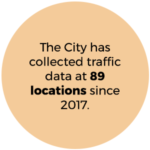 Traffic Calming: Using similar principles as Neighborways, the Transportation & Infrastructure team has used low-cost interventions to reduce travel speeds and slow turning movements. Over the last couple of years, T&I has developed a system of collecting data and monitoring after interventions. They’ve even created a petition process for residents to notify staff of problem streets.
Traffic Calming: Using similar principles as Neighborways, the Transportation & Infrastructure team has used low-cost interventions to reduce travel speeds and slow turning movements. Over the last couple of years, T&I has developed a system of collecting data and monitoring after interventions. They’ve even created a petition process for residents to notify staff of problem streets.- Parking Compliance: Due to better communication of parking policies, the City has seen a steady increase in parking compliance (and a reduction in ticket issuance).
- Parking Permits Available Online: Ordering parking permits online has been such a fact of life for so many, but it was actually an action identified in SomerVision 2030 and implemented by Traffic and Parking,
- Business Parking Permits: In 2013, the Traffic & Parking Department created a business permit program for employees of Somerville businesses to be able to park in underutilized spots during their shifts. These permits make it easier for businesses to retain employees and keep meter parking available for customers.
- Pickup/Dropoff: One innovation that SomerVision 2030 did not contend with is the influx in ride-hailing apps. The City has transitioned parking spots in key locations like Union Square and Davis Square into drop off, pickup zones for these rides. This helps prevent traffic congestion and improves safety. A state-mandated assessment on rideshare companies, or Transportation Network Companies, provides special revenue for the City to fund neighborhood traffic calming and the Vision Zero programs.
- Municipal Water & Sewer Updates: The Water and Sewer department did a deep dive of operations in 2016 in order to set accurate but consistent rates that cover capital investment in upgrading our aging infrastructure and reserves for emergency repairs. Engineering has updated hydraulic modeling information to better predict how climate change will affect stormwater flows to better plan capital investments.
- Infiltration & Inflow Mitigation: In 2018, the City adopted an ordinance that sets either mitigation actions or fees for projects that add additional wastewater to existing or new sewer connections. The mitigation and fees are used for alterations or improvements to the city’s main drain and common sewer system to eliminate infiltration/inflow.
- Union Square Sewer Separation Project: Phase two of this project is currently underway from Prospect Street to McGrath Highway. The first phase from Porter Square to Union Square was complete in 2010 and the final phase connecting the two separated sewer systems will begin shortly after the completion of phase two. This work benefits almost half of the city as rain and sewer flow come from places as far west as Davis Square.
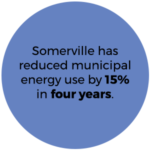 Stormwater Management: The City is currently preparing a Stormwater Management Ordinance and Regulation. The City is also participating in the Massachusetts Municipal Vulnerability Preparedness Program, receiving a $350,000 grant in 2018 to plan for built and natural stormwater management solutions.
Stormwater Management: The City is currently preparing a Stormwater Management Ordinance and Regulation. The City is also participating in the Massachusetts Municipal Vulnerability Preparedness Program, receiving a $350,000 grant in 2018 to plan for built and natural stormwater management solutions.- Community Choice Electricity Program: The City of Somerville started a new electricity bulk buying program for households and businesses in 2017. The goal of the program is to reduce and stabilize the cost of electricity for residents and businesses in Somerville, as well as increase the share of renewable “green” energy in Somerville’s electricity supply.
GET INVOLVED: Learn more about the program and opt-in to renewable electricity.


